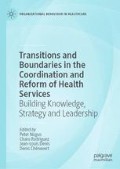Abstract
Collaboration is a key component of high-quality health systems and is particularly important when facing so-called wicked issues. This chapter examines cross-sector collaboration as a function of the notion of ‘boundary work’. It examines the wicked issue of the prevalence of crusted scabies in Indigenous populations living in remote communities in the Northern Territory of Australia, which will require significant collaborative work across a range of different organisational and institutional boundaries if it is to be successful. We research a new approach driven by a philanthropic organisation called One Disease and find this programme has been successful in many respects principally because of this organisation’s ability to work closely with a range of stakeholders.
Access this chapter
Tax calculation will be finalised at checkout
Purchases are for personal use only
References
Allen, D. (2000). Doing occupational demarcation: The ‘boundary-work’ of nurse managers in a district general hospital. Journal of Contemporary Ethnography,29(3), 326–356.
Australian Institute of Health and Welfare. (2015). The health and welfare of Australia’s Aboriginal and Torres Strait Islander peoples: 2015. Canberra: AIHW.
Barber, J. T., Brolan, C. E., & Hill, P. S. (2014). Aboriginal medical services cure more than illness: A qualitative study of how indigenous services address the health impacts of discrimination in Brisbane communities. International Journal for Equity in Health,13, 56.
Carapetis, J., Connors, C., Yarmirr, D., Krause, V., & Currie, B. (1997). Success of a scabies control program in an Australian aboriginal community. The Pediatric Infectious Disease Journal,16, 494–499.
Commonwealth of Australia. (2015). Reform of the federation: Discussion paper. Canberra: Commonwealth of Australia.
Dickinson, H. (2014). Making a reality of integration: Less science, more craft and graft. Journal of Integrated Care,22, 189–196.
Dickinson, H., & Ledger, J. (2017). Accelerating research translation in healthcare: The Australian approach. In A. McDermott, M. Kitchener, & M. Exworthy (Eds.), Managing improvement in healthcare: Attaining, sustaining and spreading quality. Basingstoke: Palgrave Macmillan.
Dickinson, H., & O’Flynn, J. (2016). Evaluating outcomes in health and social care. Bristol: Policy Press.
Dowdle, W. R. (1999). The principles of disease elimination and eradication. CDC MMWR,48, 23–27.
Dyer, O. (2006). In search of a sustainable philanthropy. Bulletin of the World Health Organization,84, 432–433.
Freeman, T., Baum, F., Lawless, A., Labonte, R., Sanders, D., Boffa, J., et al. (2016). Case study of an aboriginal community-controlled health service in Australia: Universal, rights-based, publicly funded comprehensive primary health care in action. Health and Human Rights Journal,18, 93–108.
Gardner, K., Van Gool, K., van der Linden, N., Agostino, J., Campbell, M., Dickinson, H., et al. (2018). Evaluation of the one disease crusted scabies elimination project. Canberra: Public Service Research Group, Business School, University of New South Wales.
Giarelli, G., Annandale, E., & Ruzza, C. (2014). The role of civil society in healthcare systems reforms. Social Science and Medicine,123, 160–167.
Hay, R., Steer, A., Engelman, D., & Walton, S. (2012). Scabies in the developing world—Its prevalence, complications, and management. Clinical Microbiology and Infection, 18, 313–323.
Head, B. W., & Alford, J. (2015). Wicked problems: Implications for public policy and management. Administration & Society,47, 711–739.
McKeon, S., Alexander, E., Brodaty, H., Ferris, B., Fraxer, I., & Little, M. (2013). Strategic review of health and medical research. Canberra: Department of Health.
O’Flynn, J. (2014). Crossing boundaries: The fundamental questions in public management and policy. In J. O’Flynn, D. Blackman, & J. Halligan (Eds.), Crossing boundaries in public management and policy: The international experience. London: Routledge.
Quilty, S., Kaye, T., & Currie, B. (2017). Crusted scabies in northern and central Australia—Now is the time for eradication. Medical Journal of Australia,206, 296.
Romani, L., Steer, A. C., Whitfield, M. J., & Kaldor, J. M. (2015). Prevalence of scabies and impetigo worldwide: A systematic review. Lancet Infectious Diseases,15, 960–967.
Roy, M., Baker, R., & Kerr, S. (2017). Conceptualising the public health role of actors operating outside of formal health systems: The case of social enterprise. Social Science and Medicine,172, 144–152.
Strong, M., & Johnstone, P. (2007). Interventions for treating scabies. Cochrane Database Systematic Reviews, 18(3), Cd000320.
Thornley, S., Marshall, R., Jarrett, P., Sundborn, G., Reynolds, E., & Schofield, G. (2018). Scabies is strongly associated with rheumatic fever in a cohort study of Auckland children. Journal of Paediatrics and Child Health,54, 625–632.
Williams, P. (2012). Collaboration in public policy and practice: Perspectives on boundary spanners. Bristol: Policy Press.
Author information
Authors and Affiliations
Corresponding author
Editor information
Editors and Affiliations
Rights and permissions
Copyright information
© 2020 The Author(s)
About this chapter
Cite this chapter
Dickinson, H., Gardner, K., Dowden, M., van der Linden, N. (2020). Driving Change Across Boundaries: Eliminating Crusted Scabies in Northern Territory, Australia. In: Nugus, P., Rodriguez, C., Denis, JL., Chênevert, D. (eds) Transitions and Boundaries in the Coordination and Reform of Health Services. Organizational Behaviour in Healthcare. Palgrave Macmillan, Cham. https://doi.org/10.1007/978-3-030-26684-4_3
Download citation
DOI: https://doi.org/10.1007/978-3-030-26684-4_3
Published:
Publisher Name: Palgrave Macmillan, Cham
Print ISBN: 978-3-030-26683-7
Online ISBN: 978-3-030-26684-4
eBook Packages: Business and ManagementBusiness and Management (R0)

